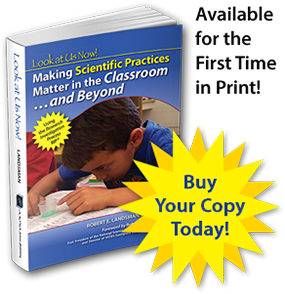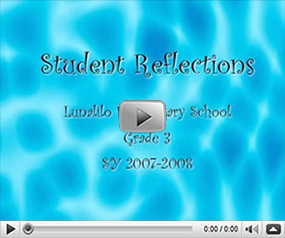RIP® Model - Scientific Practices & STEM
The Research Investigation Process (RIP®) naturally invites the integration of the four content areas of STEM (science, technology, engineering, and mathematics) within each investigation. Whether intentional or not, using the RIP® as the instructional framework will always include STEM content. First, the RIP® can be used to facilitate the learning of new information in one or more of the four STEM content areas. Also, at the very least, every RIP®-based research investigation will involve student use of some or all of the scientific and engineering practices described in the Next Generation Science Standards (NGSS), application of mathematics for the analysis of data, and the use of technology for a variety of purposes. This can be seen throughout the inquiries described in Look at Us Now! Making Scientific Practices Matter in the Classroom…and Beyond.
The ease of incorporation of STEM concepts and skills into the learning process makes the RIP® an ideal model for STEM education.
- RIP® scientific inquiry initiated in the classroom may or may not directly focus on learning new SCIENCE content. However, the investigation will always include application of scientific inquiry and the scientific practices.
- TECHNOLOGY is heavily embedded in RIP® investigations through the use of computers and mobile devices with the Internet for gathering background information and for communication with research colleagues and experts in the research field; computer hardware and software for collection, maintenance, summarization, analysis, and presentation of data that will be used as evidence for testing a hypothesis; and/or the use of scientific or engineering tools (e.g., scopes for magnifying, laser measurement tools, etc.). During the proposal and final phases of the research investigation, technology is used to deliver presentations to an audience for assessment and knowledge sharing purposes. Technology use or products may be the target of the investigation, such as studying cell phone reception in different locations.
- ENGINEERING is represented through the designing of the method within the research investigation, including selection or development of materials used, research design, and procedure; the use of the NGSS engineering practices; and/or the designing and/or building of a product as a solution to a problem.
- MATHEMATICS is integral to scientific inquiry. The results component of the investigation will always involve collecting and analyzing some form of data.
Often the RIP® inquiry model will be used to target the learning of content in subject areas other than science, technology, engineering, or mathematics, such as language arts or social studies. At the same time, this model of scientific inquiry always requires the application of aspects of each of the four STEM content areas as discussed above. Examples of this can be found in Chapters 5, 7, and 10 of Look at Us Now!
Engineering is integrated not only through the engineering practices that flow throughout every inquiry, but also through the development and use of models as well as the designing and building of solutions to problems based on final outcomes or findings. For example, Chapter 1 of Look at Us Now! discusses the designing and building of model oceans as part of the method component of an environmental science research investigation. Chapter 2 describes the design and development of models based on the results of an investigation that could serve as solutions to ocean oil spills.
The RIP® is heavily dependent upon the integration of mathematics and student proficiency in the use of mathematics for data collection, summary, analysis, and presentation. In addition, the investigation may directly target the learning of mathematical concepts. Thus, the development of mathematical skills necessary to conduct the investigation also becomes the basis for learning these skills in context, while the understanding and use of particular mathematical concepts may be a primary focus of the investigation. Examples of this can be seen in Chapters 5 and 7 of Look at Us Now! Making Scientific Practices Matter in the Classroom…and Beyond.
Your Shopping Cart
Ordering five (5) or more copies? Contact us for a special volume discount.
Read the Foreword
Enter your name and e-mail address below for immediate access to read the complete Foreword, written by Dr. Robert E. Yager, in its entirety.


 ANOVA Science
ANOVA Science